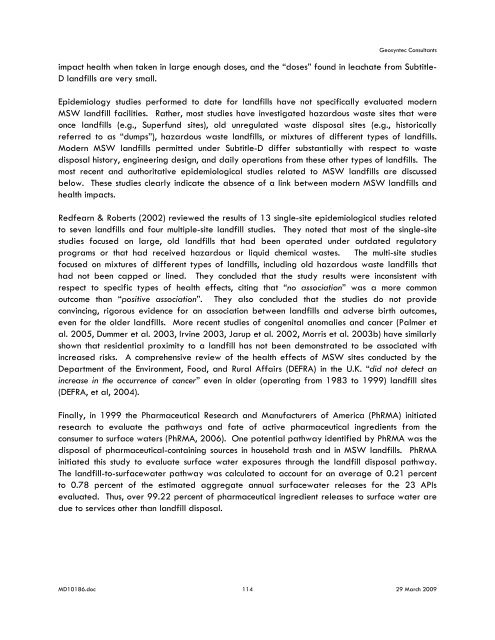AREA A/B ENGINEERING REPORT - Waste Management
AREA A/B ENGINEERING REPORT - Waste Management
AREA A/B ENGINEERING REPORT - Waste Management
Create successful ePaper yourself
Turn your PDF publications into a flip-book with our unique Google optimized e-Paper software.
Geosyntec Consultants<br />
impact health when taken in large enough doses, and the “doses” found in leachate from Subtitle-<br />
D landfills are very small.<br />
Epidemiology studies performed to date for landfills have not specifically evaluated modern<br />
MSW landfill facilities. Rather, most studies have investigated hazardous waste sites that were<br />
once landfills (e.g., Superfund sites), old unregulated waste disposal sites (e.g., historically<br />
referred to as “dumps”), hazardous waste landfills, or mixtures of different types of landfills.<br />
Modern MSW landfills permitted under Subtitle-D differ substantially with respect to waste<br />
disposal history, engineering design, and daily operations from these other types of landfills. The<br />
most recent and authoritative epidemiological studies related to MSW landfills are discussed<br />
below. These studies clearly indicate the absence of a link between modern MSW landfills and<br />
health impacts.<br />
Redfearn & Roberts (2002) reviewed the results of 13 single-site epidemiological studies related<br />
to seven landfills and four multiple-site landfill studies. They noted that most of the single-site<br />
studies focused on large, old landfills that had been operated under outdated regulatory<br />
programs or that had received hazardous or liquid chemical wastes. The multi-site studies<br />
focused on mixtures of different types of landfills, including old hazardous waste landfills that<br />
had not been capped or lined. They concluded that the study results were inconsistent with<br />
respect to specific types of health effects, citing that “no association” was a more common<br />
outcome than “positive association”. They also concluded that the studies do not provide<br />
convincing, rigorous evidence for an association between landfills and adverse birth outcomes,<br />
even for the older landfills. More recent studies of congenital anomalies and cancer (Palmer et<br />
al. 2005, Dummer et al. 2003, Irvine 2003, Jarup et al. 2002, Morris et al. 2003b) have similarly<br />
shown that residential proximity to a landfill has not been demonstrated to be associated with<br />
increased risks. A comprehensive review of the health effects of MSW sites conducted by the<br />
Department of the Environment, Food, and Rural Affairs (DEFRA) in the U.K. “did not detect an<br />
increase in the occurrence of cancer” even in older (operating from 1983 to 1999) landfill sites<br />
(DEFRA, et al, 2004).<br />
Finally, in 1999 the Pharmaceutical Research and Manufacturers of America (PhRMA) initiated<br />
research to evaluate the pathways and fate of active pharmaceutical ingredients from the<br />
consumer to surface waters (PhRMA, 2006). One potential pathway identified by PhRMA was the<br />
disposal of pharmaceutical-containing sources in household trash and in MSW landfills. PhRMA<br />
initiated this study to evaluate surface water exposures through the landfill disposal pathway.<br />
The landfill-to-surfacewater pathway was calculated to account for an average of 0.21 percent<br />
to 0.78 percent of the estimated aggregate annual surfacewater releases for the 23 APIs<br />
evaluated. Thus, over 99.22 percent of pharmaceutical ingredient releases to surface water are<br />
due to services other than landfill disposal.<br />
MD10186.doc 114 29 March 2009

















